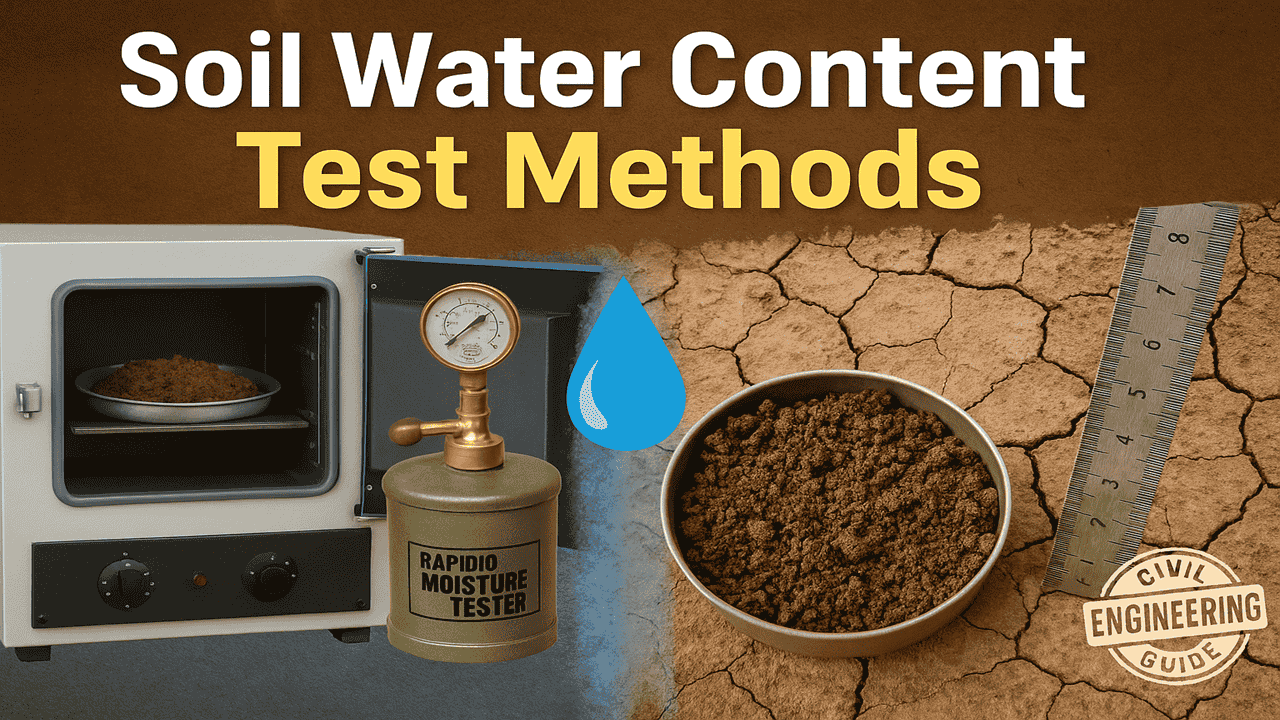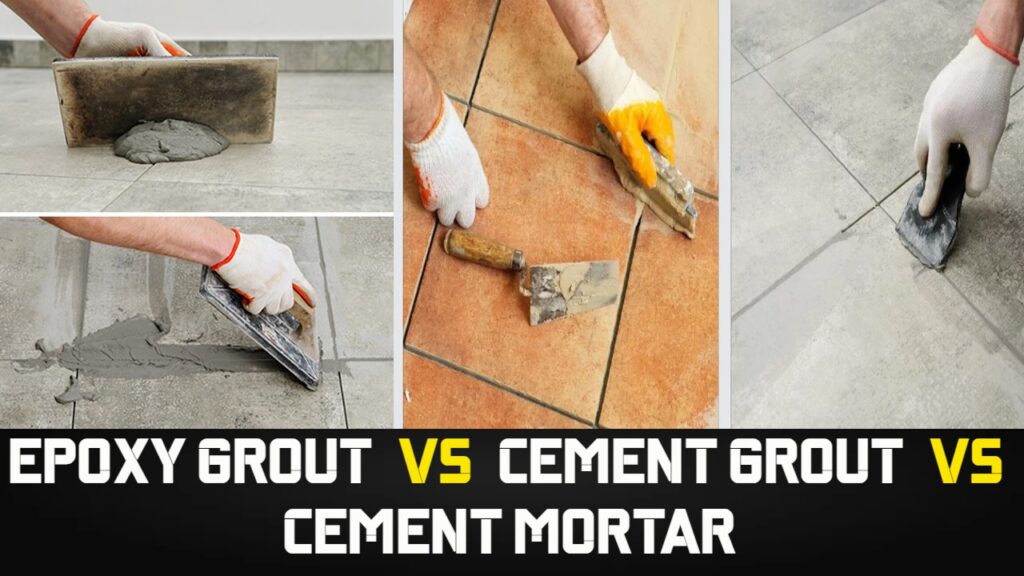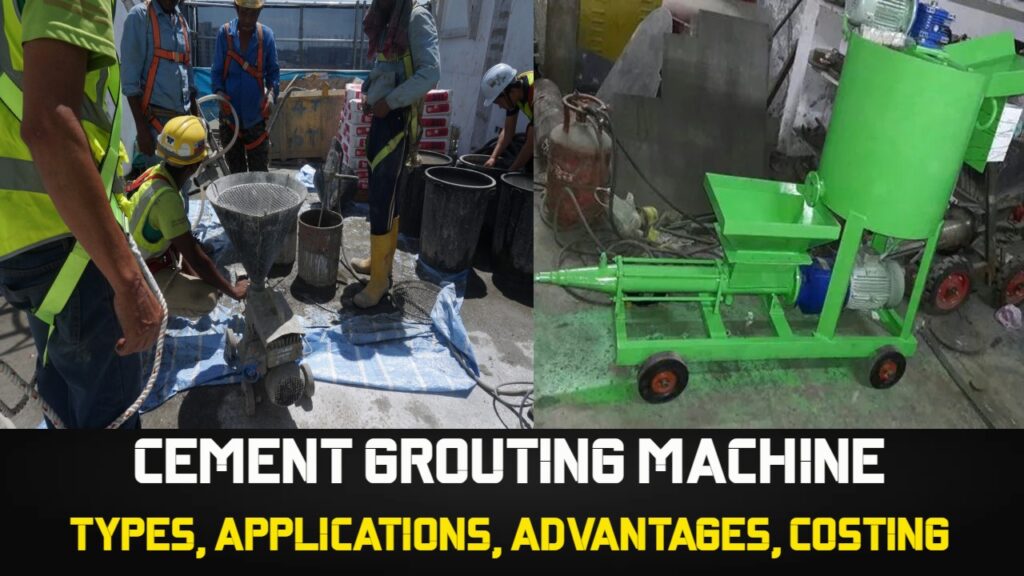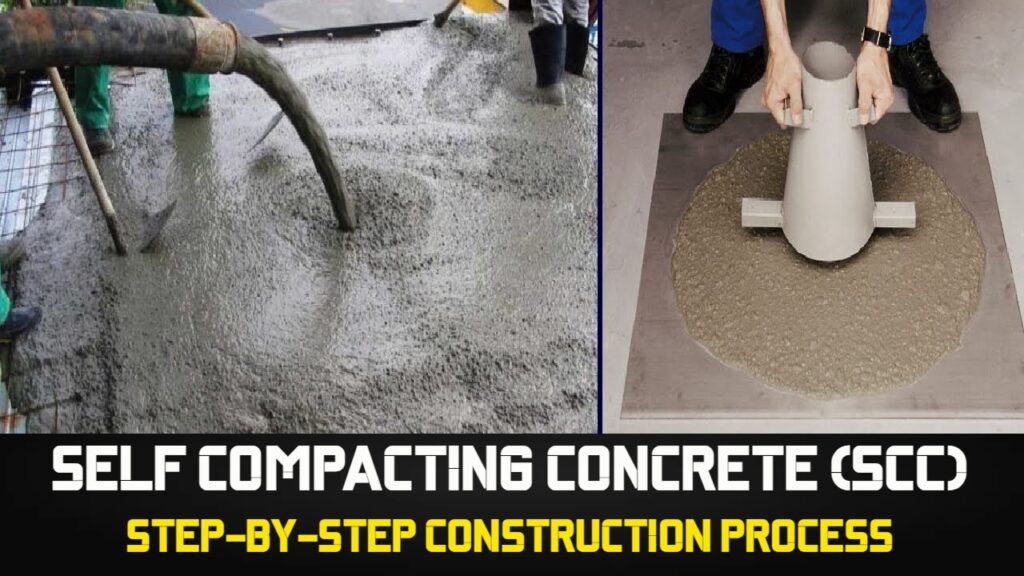Water Content Determination: In the field of civil engineering, soil acts as the fundamental base for all types of construction work. The nature and properties of soil—particularly its water content—play a key role in determining the stability and longevity of any structure built upon it. For instance, sandy soil promotes good water drainage, while clayey soil, when properly compacted, offers a high load-bearing capacity. Therefore, essential soil characteristics such as moisture content, compaction, and shear strength must be thoroughly understood to ensure a strong and stable foundation.
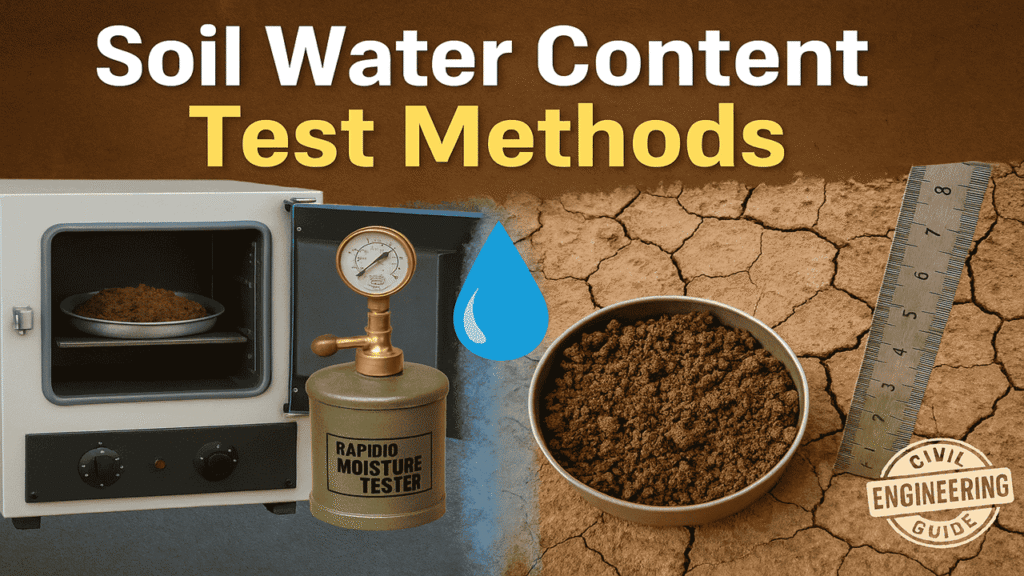
Soil water content refers to the amount of moisture present in the soil compared to its dry weight. This parameter is crucial because it significantly influences the soil’s behavior, affecting properties such as strength, workability, and drainage.
Accurate determination of soil moisture is vital in both agriculture and construction sectors. In construction, achieving the desired strength of the foundation soil depends heavily on proper compaction, which is only possible when the moisture content is within the optimal range.
If the soil has either excessive or insufficient moisture, it can lead to poor compaction. This imbalance may result in serious issues like reduced load-bearing capacity, soil settlement, and even slope instability. Hence, measuring and maintaining the correct water content in soil is essential for safe and durable construction practices.
Different Methods for Determining Moisture Content in Soil
There are several methods available to determine the water content of soil, each designed for specific conditions and levels of accuracy. While all methods aim to measure moisture levels, only a few provide highly precise results. However, this does not diminish the value of other techniques, as each has its own advantages and limitations.
Some methods are best suited for laboratory environments where controlled conditions ensure accuracy, while others are quick and convenient for on-site testing. The choice of method often depends on the purpose, available equipment, and required precision. Let’s explore the most commonly used techniques in detail.
Contents
- 1 1. Oven Drying Method (Standard Method – IS: 2720 Part 2)
- 2 2. Pycnometer Method
- 3 3. Calcium Carbide (Rapid Moisture) Method
- 4 4. Sand Bath Method
- 5 5. Alcohol Method
- 6 6. Radiation Method
- 7 Which Method is Considered the Most Precise for Measuring Soil Water Content and Why?
- 8 Which Method Provides the Fastest Measurement of Water Content Determination of Soil and why?
- 9 How Long Does It Take for Water Content Determination of Soil by Different Methods?
1. Oven Drying Method (Standard Method – IS: 2720 Part 2)
The oven drying method is based on the principle of removing all moisture content from a soil sample by heating it in an oven at a constant temperature range of 105°C to 110°C for 24 hours. The loss in weight after drying represents the amount of water originally present in the soil. This change in mass is then used to calculate the water content.
Procedure:
- Take a clean, dry moisture container and weigh it accurately (W₀).
- Place a representative moist soil sample into the container and weigh the combined mass (W₁).
- Put the container with the soil sample into a hot air oven maintained at a temperature of 105°C to 110°C.
- Dry the sample for 24 hours or until the weight becomes constant, indicating all moisture has evaporated.
- Remove the container from the oven, cool it in a desiccator to avoid moisture absorption from the air, and weigh it again (W₂).
- Calculate the water content using the formula below.
Formula:
Water Content (w%) = [(W1−W2)/(W2−W0)]×100
Where:
- W0 = Weight of empty container
- W1 = Weight of container + moist soil
- W2 = Weight of container + dry soil
Advantages:
The oven drying method is highly accurate and widely recognized as the standard procedure for determining soil moisture content in laboratories. It provides reliable and repeatable results, making it the benchmark for validating other rapid moisture tests. The method is straightforward and requires only basic equipment, which is easily available.
Limitations:
This method is time-consuming, requiring at least 24 hours to obtain results. It is unsuitable for soils containing organic matter or gypsum, as heating can cause loss of chemically bound water, leading to inaccurate moisture values. Additionally, the test must be conducted in a controlled laboratory environment with a reliable power source to maintain the required drying temperature.
2. Pycnometer Method
A pycnometer is a glass container with a capacity of approximately one liter, equipped with a brass conical lid that is secured by a screw-on mechanism. The lid features a small hole, about 6 mm in diameter, at its tip. To prevent any leakage, a rubber or fiber gasket is placed between the jar and the lid. Both the jar and the lid have alignment marks so that the lid can be fastened consistently to the same position, ensuring the volume of the pycnometer remains constant for measurement purposes. This method for determining soil water content can only be applied when the specific gravity of the solid particles is already known.
Procedure:
- Clean and dry the pycnometer and weigh it empty (W₀).
- Add a known amount of moist soil sample into the pycnometer and weigh the combined weight (W₁).
- Fill the pycnometer with distilled water up to the marked level, ensuring no air bubbles remain, and weigh it again (W₂).
- Empty the pycnometer, clean it thoroughly, then fill it with distilled water alone up to the marked level and weigh it (W₃).
- Use these weights along with the specific gravity of soil solids (G) to calculate the water content.
Formula:

Where:
- W0 = Weight of empty pycnometer
- W1 = Weight of pycnometer + moist soil
- W2 = Weight of pycnometer + soil + water
- W3 = Weight of pycnometer + water only
- G = Specific gravity of soil solids
Advantages:
The pycnometer method provides fairly accurate moisture content results when the specific gravity of soil particles is known. It requires only a small soil sample and can be useful for fine-grained soils where other quick methods may not be as effective. The equipment is simple and does not require heating.
Limitations:
This method depends on knowing the precise specific gravity of soil solids, which can vary. It is not suitable for soils with organic matter or varying particle densities. The procedure requires careful handling to avoid errors caused by trapped air bubbles or water leakage, and it is less commonly used for routine moisture content testing compared to the oven drying method.
3. Calcium Carbide (Rapid Moisture) Method
The Calcium Carbide (Rapid Moisture) Method is a quick and efficient technique used to determine the water content of soil. In this method, a small soil sample is placed inside a sealed container along with a measured amount of calcium carbide. When calcium carbide reacts with the moisture present in the soil, it produces acetylene gas. The pressure generated by this gas inside the container is directly proportional to the amount of water in the soil. By measuring the pressure with a pressure gauge or a specialized moisture tester, the water content can be quickly estimated. This method is widely favored for its rapid results, portability, and ease of use, especially in field conditions where traditional oven-drying methods may be impractical or time-consuming. However, it requires careful handling of calcium carbide as it is a reactive chemical.
Procedure:
- Take a small, representative soil sample (usually about 20 to 50 grams) and place it inside the sealed chamber of the rapid moisture tester.
- Add a measured amount of calcium carbide powder into the chamber with the soil.
- Close the chamber tightly and shake it vigorously for about 3 to 5 minutes.
- The calcium carbide reacts with the water in the soil to produce acetylene gas, increasing the pressure inside the chamber.
- The built-in pressure gauge measures the pressure generated by the acetylene gas.
- Using a calibration chart or formula provided with the equipment, convert the pressure reading into the percentage of water content in the soil.
Formula:
Water content is generally read directly from the pressure gauge calibrated to moisture content. However, if a formula is used, it is based on the relation:
w% = k×P
Where:
- w% = Moisture content in percentage
- P = Pressure reading from the gauge
- k = Calibration constant specific to the tester and soil type
Advantages:
The calcium carbide method provides rapid results, often within minutes, making it very convenient for field testing and quick decisions. It requires only a small amount of soil and does not need any heating or electricity. This method is portable and simple to use, allowing moisture content determination directly at the site.
Limitations:
Although fast, this method is less accurate than the standard oven drying technique. It may give unreliable results if the soil contains organic matter or chemicals that react with calcium carbide differently. Calcium carbide is a hazardous chemical and must be handled carefully to avoid accidents. The equipment requires regular calibration, and the test is generally unsuitable for precise laboratory analysis.
4. Sand Bath Method
The Sand Bath Method determines soil water content by heating a soil sample placed in a container surrounded by hot sand. The sand provides uniform heat, preventing sudden evaporation. After drying, the weight loss indicates moisture content. This method is simple but slower than modern techniques and suited for laboratory use.
Procedure:
- Heat a clean sand bath uniformly over a stove or burner until the sand is hot enough to dry soil samples effectively.
- Take a clean, dry moisture container or dish and weigh it (W₀).
- Place a moist soil sample in the container and weigh the combined weight (W₁).
- Put the container with the soil sample on the hot sand bath.
- Heat gently, stirring the soil occasionally to ensure even drying and prevent localized overheating or burning.
- Remove the sample periodically and weigh it (W₂) after cooling in a desiccator.
- Repeat the heating and weighing until the weight remains constant, indicating that all moisture has evaporated.
- Calculate the water content using the formula below.
Formula:
Water Content (w%) = [(W1−W2)/(W2−W0)]×100
Where:
- W0 = Weight of empty container
- W1 = Weight of container + moist soil
- W2 = Weight of container + dry soil
Advantages:
The sand bath method is a low-cost and practical alternative to oven drying, especially useful when an electric oven is unavailable, such as in remote or field conditions. It allows gentle and uniform heating, reducing the chances of burning the soil sample. The equipment required is simple and easy to use, making it accessible for quick moisture estimation.
Limitations:
Compared to the standard oven drying method, the sand bath is less precise and may take longer to achieve complete drying. Care must be taken to avoid overheating, which can alter soil properties or cause decomposition, especially in organic-rich soils. This method is not standardized by major testing codes, so results can vary based on operator experience and equipment quality. It is not recommended for soils that are sensitive to heat or contain volatile components.
5. Alcohol Method
The Alcohol Method for determining soil water content involves placing a soil sample in a container filled with a known volume of alcohol, typically ethanol or isopropyl alcohol. The alcohol penetrates the soil pores and mixes with the water present. Since alcohol and water are miscible, the volume change or weight difference after mixing helps estimate the moisture content. This method is useful for soils where drying at high temperatures may alter the soil properties or for rapid field testing. However, it is less accurate compared to oven-drying and requires careful handling of alcohol due to its flammability and health risks.
Procedure:
- Take a clean, dry moisture container and weigh it (W₀).
- Place a known quantity of moist soil sample in the container and record the combined weight (W₁).
- Fill the container with alcohol (usually ethanol or methanol) until the soil is completely submerged. Alcohol displaces the water from the soil pores without dissolving the soil particles.
- Allow the sample to soak for several hours to ensure complete water displacement by the alcohol.
- Remove the alcohol and dry the soil sample completely in an oven at 105°C to 110°C until a constant weight is achieved (W₂).
- Calculate the water content using the formula below.
Formula:
Water Content (w%) = [(W1−W2)/(W2−W0)]×100
Where:
- W0 = Weight of empty container
- W1 = Weight of container + moist soil
- W2 = Weight of container + dry soil after alcohol treatment
Advantages:
The alcohol method is useful for soils that contain soluble salts or organic matter, which might interfere with the oven drying method. It helps avoid the loss of volatile substances during drying. This method can also be used when the soil has substances that react with water, making water content determination by other methods difficult.
Limitations:
This method is time-consuming due to the soaking period required for alcohol to displace water completely. It requires careful handling and disposal of alcohol, which is flammable and toxic. Additionally, it may not be suitable for all soil types, and the accuracy is generally lower compared to the oven drying method. The procedure is also more complex and less commonly used.
6. Radiation Method
The Radiation Method measures soil water content by using radioactive sources like gamma rays or neutrons. These radiations interact with hydrogen in soil water, allowing moisture estimation without disturbing the soil. It provides quick, accurate results but requires special equipment and safety measures due to radiation exposure.
Procedure:
- The soil sample is exposed to a source of radiation, typically gamma rays or neutrons, which penetrate the soil.
- The interaction between the radiation and the soil moisture causes attenuation or scattering of the radiation, which is measured by a detector placed on the opposite side or nearby.
- The intensity of the detected radiation decreases with increasing moisture content, as water absorbs or scatters the radiation differently than dry soil particles.
- The detected signal is converted into water content using a calibration curve developed from soil samples with known moisture content.
- This method can be performed in the laboratory or directly in the field using portable nuclear moisture gauges.
Formula:
The water content is generally calculated using a calibration equation of the form:
w =a + b × ln(I)
Where:
- w = Soil moisture content (%)
- I = Intensity of detected radiation
- a,b = Empirical constants determined from calibration
Advantages:
The radiation method provides rapid, non-destructive, and accurate measurements of soil moisture. It allows for in-situ measurement without disturbing the soil, making it ideal for field applications. It is especially useful for monitoring moisture over time in agriculture, hydrology, and geotechnical investigations.
Limitations:
The equipment used in the radiation method can be expensive and requires careful handling due to the radioactive sources involved, necessitating safety precautions and regulatory compliance. Calibration is soil-specific and must be performed carefully to ensure accurate results. The presence of other materials or soil heterogeneity can affect measurement accuracy. It is less practical for routine testing in small laboratories.
Which Method is Considered the Most Precise for Measuring Soil Water Content and Why?
The oven drying method is considered the most precise for measuring soil water content because it completely removes all moisture by heating the soil sample at a controlled temperature, usually around 105°C, until a constant weight is reached. This ensures that no water remains, providing an accurate measurement of the soil’s moisture. It is widely accepted and standardized by organizations like ASTM and IS, making it a reliable benchmark. Although it takes longer than other methods, its accuracy and consistency make it the preferred choice for laboratory analysis and calibration of faster moisture determination techniques.
Which Method Provides the Fastest Measurement of Water Content Determination of Soil and why?
The calcium carbide method is the fastest for measuring soil water content, providing results within 3 to 5 minutes. It works by reacting calcium carbide with moisture in the soil to produce acetylene gas, and the resulting gas pressure indicates the water content. This method is ideal for quick, on-site testing, but its accuracy is lower than the oven-drying method, which is preferred for precise laboratory measurements.
How Long Does It Take for Water Content Determination of Soil by Different Methods?
| Method | Approximate Time Required | Remarks |
| Oven-Drying (Standard) | ~24 hours | Most accurate, laboratory standard |
| Sand-Bath | Few hours | Faster than oven-drying, less precise |
| Alcohol Method | Less than 30 minutes | Quick, suitable for various soil types |
| Pycnometer Method | Less than 30 minutes | Laboratory method, moderate accuracy |
| Radiation Method | 30–60 minutes | Non-destructive, requires special tools |
| Calcium Carbide (Rapid) | 3–5 minutes | Fastest, ideal for field use |
Note: Actual time may vary based on soil type, environmental conditions, and equipment efficiency.
